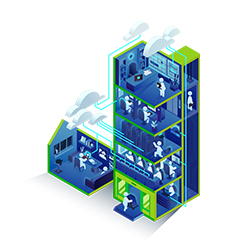Author: Angad Soni
Chief Architect, Business Applications & Data Modernization
Long View

Artificial intelligence (AI) is shaking up our world like never before, bringing both exciting possibilities and tough challenges for everyone involved. But not all AI is cut from the same cloth. Different AI setups and models come with varying levels of transparency, accountability, and ethics. And believe it or not, these differences matter big time when it comes to how AI gets used, adopted, and studied.
So, how do we make sure AI stays on the straight and narrow, while being diverse, transparent and ethical in a forever changing landscape? And how do we make sure our organizations walk the talk and align their policies and values with the AI they choose to use or create? These are the kinds of questions we want to answer while drawing from our own mix of professional experiences and viewpoints on AI. Let's unpack this and dive in.
Transparency and Ethical AI
What is transparent AI and why is it important? Transparent AI can explain its inputs, outputs, processes, and decisions in a clear and understandable way. This is a really big deal for several reasons:
- It fosters trust and confidence among AI users, customers, stakeholders, and regulators.
- It enables accountability and responsibility for AI actions and outcomes, allowing for monitoring, evaluation, and feedback.
- And it promotes ethical and fair AI practices, ensuring that AI respects human values, rights, and dignity.
But how do varying AI frameworks offer different levels of transparency? Let’s take a look at how frameworks such as deep learning, symbolic AI, and hybrid AI work to achieve this:
- Deep learning uses neural networks to learn from large amounts of data to perform complex tasks. However, deep learning is often considered a black box, which can make it difficult to understand how it works and why it makes certain decisions.
- Symbolic AI uses logic, rules, and symbols to represent and manipulate knowledge and reasoning. This framework is often considered more transparent than deep learning, since it can provide explicit and formal explanations for its actions and decisions.
- Hybrid AI combines deep learning and symbolic AI, aiming to leverage the strengths of both approaches. Hybrid AI can potentially offer more transparency than deep learning alone, as it can use symbolic AI to interpret and explain the results of deep learning.
With how different frameworks impact AI transparency in mind, let’s shift focus to how organizational policies influence AI transparency and ethics. These policies significantly influence how AI is adopted, used, and researched, so an organization should prioritize transparency to foster trust and ethical AI practices:
- Define the goals and objectives of AI solutions, as well as the ethical and legal implications and risks.
- Establish the standards and criteria for AI transparency, such as the level of detail, clarity, and accuracy of AI explanations.
- Require the documentation and disclosure of AI inputs, outputs, processes, and decisions, as well as the sources and quality of data and algorithms.
- Encourage the participation and consultation of users, customers, stakeholders, and experts in AI development and deployment, as well as the feedback and grievance mechanisms for AI issues and concerns.
Fit-for-Purpose AI Solutions and Policy Implications
In our diverse professional experiences, from cloud-first government solutions to retail data modernization, we’ve learned that AI frameworks should be selected based on policy-driven considerations, ensuring compliance and ethical alignment. The following are a few questions you should consider when selecting your AI framework:
- What are the goals and objectives of the AI solution? The AI framework should be able to achieve the desired outcomes and performance, as well as support the organizational vision and mission.
- What are the ethical and legal implications of the AI solution? The AI framework should respect the organizational values and principles, as well as the relevant laws and regulations, such as data protection, privacy, and human rights.
- How can the AI solution be monitored and evaluated for transparency and accountability? The AI framework should provide sufficient and appropriate information and explanations for its actions and decisions, as well as allow for verification and validation of its results and impacts.
The Human Impact and Policy Influence
What exactly is Human-Centric AI? Well, it's all about making sure AI is on Team Human. That means designing, developing, and deploying it in a way that serves our needs, values, and interests. We're flipping the script here, making sure AI works for us, not the other way around.
Here are a few key principles and practices we should be keeping in mind:
- Respect for human dignity and autonomy: AI should treat us like the rockstars we are. It should respect our worth and give us the freedom to make our own choices without any funny business.
- Protection of human privacy and security: Your data's your business. AI should keep it under lock and key, protecting it from prying eyes and keeping you safe from harm.
- Promotion of human well-being and diversity: AI's here to make our lives better, not to play favorites. It should be all about boosting our happiness and making sure everyone gets a fair shake, no matter who they are or what they're into.
AI In The Workplace
When it comes to bringing AI into the mix, organizational policies need to be all about boosting human potential while keeping things ethical and above board.
So, what does AI in the workplace really mean? It's about having AI as your wingman, not your replacement. We're talking about AI that rolls up its sleeves and works alongside human employees, instead of stealing their thunder.
Here's the lowdown on the good and the not-so-good sides of AI in the workplace:
- Benefits: AI's like having a supercharged sidekick. It can help humans kick butt by taking care of the boring stuff, like repetitive tasks, and giving us the inside scoop with smart insights and recommendations. Plus, it's always game for cooking up fresh ideas and solutions.
- Challenges: AI isn't all rainbows and unicorns, which can throw a few curveballs. For starters, it might shake things up for human workers, leaving them feeling a bit sidelined or undervalued. And there's the whole privacy thing. AI needs to play nice and respect personal boundaries. If AI's going to be part of the team, it's gotta earn our trust and play well with others as well.
Where Do You Go From Here?
At the end of the day, navigating the AI landscape requires a balanced approach that combines diversity in AI frameworks with a strong emphasis on transparency. Organizational policies play a pivotal role in guiding AI adoption, ensuring that it is both safe and beneficial for all. As AI becomes more pervasive and powerful, we need to adopt a policy-driven approach that embraces diversity and transparency in AI frameworks and models. With the right policies and mindset, we can create AI solutions that not only get the job done, but also lift everyone up along the way.

Subscribe to our newsletter for the latest updates.